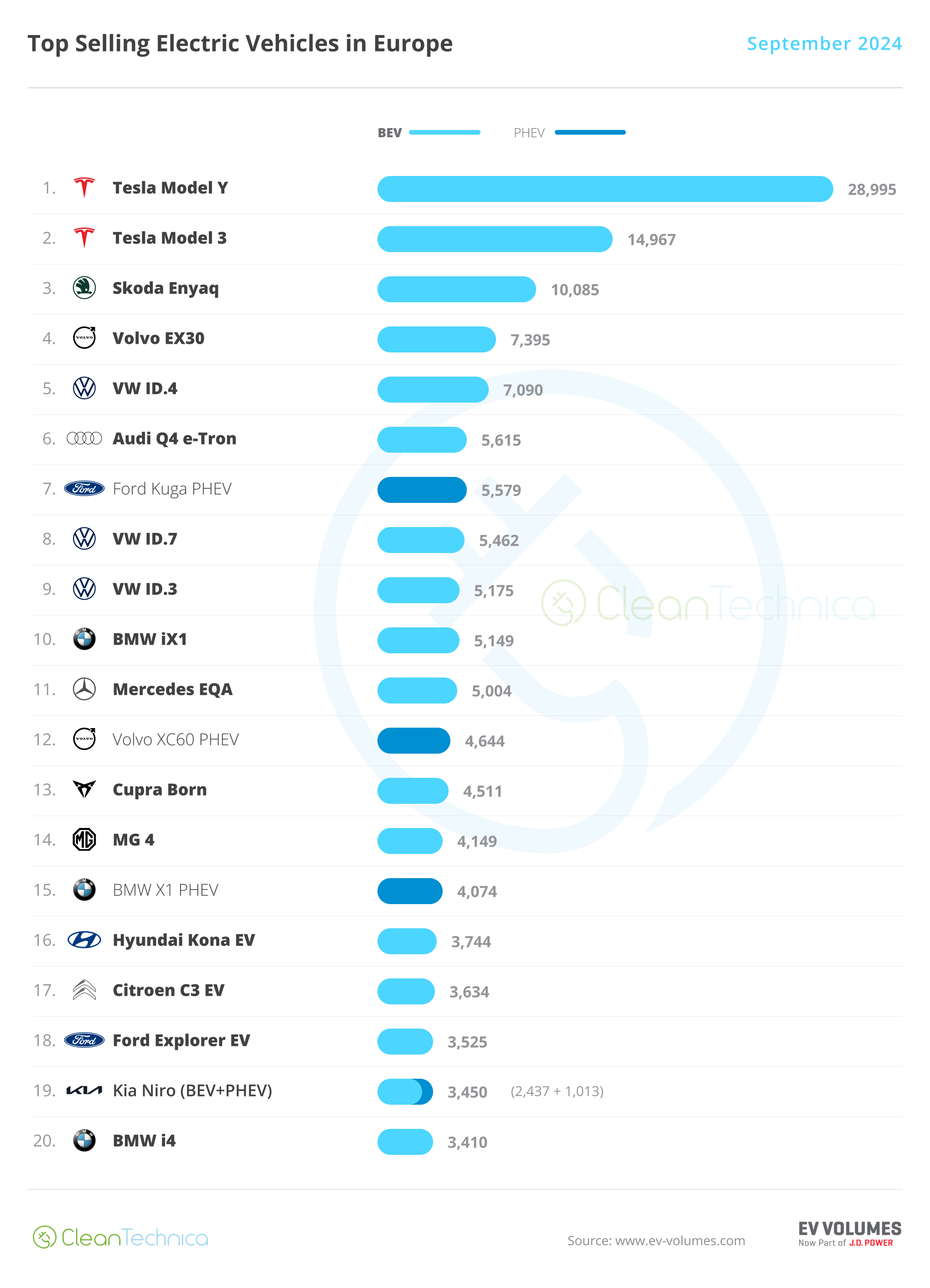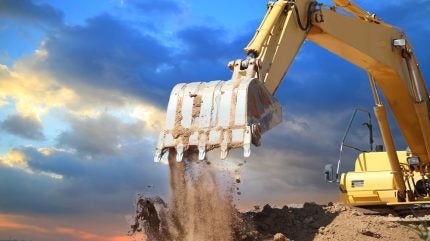Sign up for daily news updates from CleanTechnica on email. Or follow us on Google News!
Nuclear energy has had some successful scalings in the past, but seems incapable of it today. A big part of it is that the tenets of free market capitalism cause it to fall over. The same is true for small modular reactors. As people who like nuclear tend to be politically conservative and hence much more likely to be free market ideologues, the cognitive dissonance must require a jar of Ibuprofen a week. Let’s explore why.
First of all, nuclear is completely fine as a low-carbon electricity generation technology in my books. It’s efficient enough, it’s effective, it doesn’t emit greenhouse gases in operation, it lasts a few decades and it doesn’t emit air pollution. The fears of radiation are vastly overblown and a lot more people are a lot more exposed to radiation from burning coal and flying in passenger jets than from nuclear plants.
But that doesn’t mean I think it’s worth spending a lot of time or money on this decade or next. I think in the end game it will be lucky to be generating 5% of global energy when all energy is electric. That’s up a bit in absolute terms from where it is now, but down quite a bit in terms of relative share of electrical generation, and down a lot in terms of share of low-carbon generation.
Why? Let’s explore the successful nuclear generation programs of the past and then what’s happening in China. Wait, China? That’s not a free market capitalist state, you say? Read on.
Success Criteria For Nuclear Programs
As I’ve noted a few times, successful nuclear programs of the past like France’s, the USA’s, and South Korea’s share common traits.
They were national strategic programs. That means that the national government made it clear that they were a national priority, provided funding, strong-armed or otherwise overcame local opposition, and oversaw the entire thing.
The strategic programs were aligned with nuclear weapons programs. The military was all over the program sharing nuclear technology requirements, ensuring that enrichment of uranium to weapons-grade was viable, often sharing funding, providing security, and generally making sure that commercial nuclear programs enhanced military nuclear weapon programs.
The government picked a single design for all of the reactors. Competition between nuclear fission technologies and designs in the market place wasn’t allowed, the government said, “This is it.” And the design had to be proven already, and no changes permitted. That meant avoiding one of the big risks of nuclear projects, custom engineering at each site by people who thought they knew better.
The reactors were GW-scale. There are thermal efficiencies related to the size of boilers and pipes that means that all thermal generation likes to be bigger rather than smaller. The industry tried the same size of reactors that were used in nuclear-powered submarines and aircraft carriers, but they were too expensive for commercial electrical generation. As a result, they moved to GW-scale fairly quickly, and successful programs built a smaller number of larger reactors.
The government ran human resourcing. They created national training, certification and security check programs for all of the staff involved in the program from top to bottom and left to right. They got universities and trade associations together.
The programs ran for 20 or 30 years. This allowed the learnings from the first sites to be used immediately in subsequent sites. It meant the people building the reactors were able to share lessons learned and roll from site to site without slowing down. The master builders were enabled to rise and repeat successes.
And they had to build dozens of nuclear reactors. That massive investment had to be shared across a lot of reactors. Preferably, every nuclear power plant had a lot of reactors so that all of the overlapping layers of security required around the fuel supply chain and waste would be shared costs.
Anyone who wants to scale up nuclear generation has to have those conditions of success.
Does that sound or look like capitalism? Does that look like Adam Smith’s invisible hand? Does look like Hayekian free market economies? No, no it doesn’t. That’s the government being very explicitly big government and in control.
What Happens When Success Criteria Aren’t Met?
What happens when those conditions aren’t met? Well, costs and schedules balloon, so nuclear reactor construction projects become global laughingstocks. Most nuclear programs outside of the ones mentioned fall into this category. Outside of brief shining moments in time in the countries mentioned, most nuclear projects are failures.
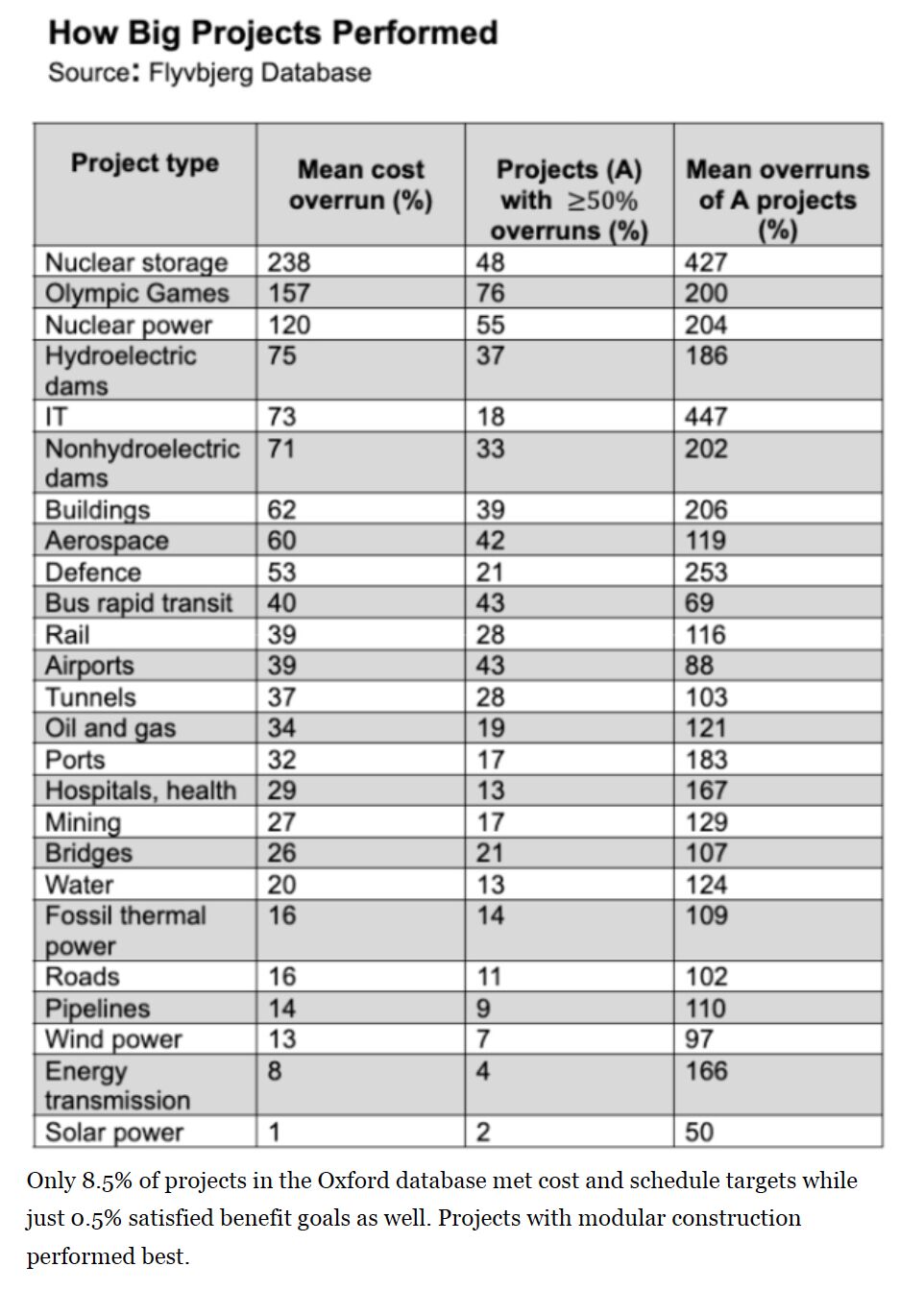
Flyvbjerg cost overruns table
This table is from Professor Bent Flyvbjerg’s analysis of his team’s database of over 16,000 billion-dollar-plus megaprojects, organized into 25 categories. You’ll note that commercial nuclear reactor projects are only worse than Olympics and nuclear waste repositories for cost over runs. The same is true for schedule overruns.
You really need a firm governmental hand on the wheel maintaining military disciple in order to build a lot of nuclear plants successfully. You have to eliminate as many long-tailed risks as possible from the program. Discipline. Single design. Repetition. Short timeframe. National human resources program. Master builders. Go buy Flyvbjerg’s book, How Big Things Get Done and then set up a program for three dozen nuclear reactors that aligns with its guidance, and you might have a chance of success.
Otherwise you get things like Hinkley Site C. That UK reactor project is now 10 years over schedule, and the budget has doubled from about US$20 billion to about $40 billion. You get Vogtle and Summer in the USA, billions and years over budget, with one of them scrapped entirely. You get the Flamanville and Olkiluoto projects, also billions and years over schedule. The only things the European examples got remotely right was picking a single design, but they failed in large part because they picked a brand new, unproven one, and didn’t commit to building a lot of them in an accelerated timeframe.
In the mid 2000s, this wasn’t exactly a secret. Then the big hope was the industry standardizing on the Westinghouse AP1000. That’s the one that was in the Vogtle and Summer plants, so that didn’t go well. That was the last time the industry thought it was in a renaissance. Wind and solar hadn’t shifted into high gear yet. HVDC hadn’t overcome its last big technical barriers with the hybrid mechanical-electronic breaker that was robust enough and fast enough, and voltage source converters (VSC) that could create tiny pixelated changes to digitally recreate the sine waves of alternating current from the flat wave of direct current.
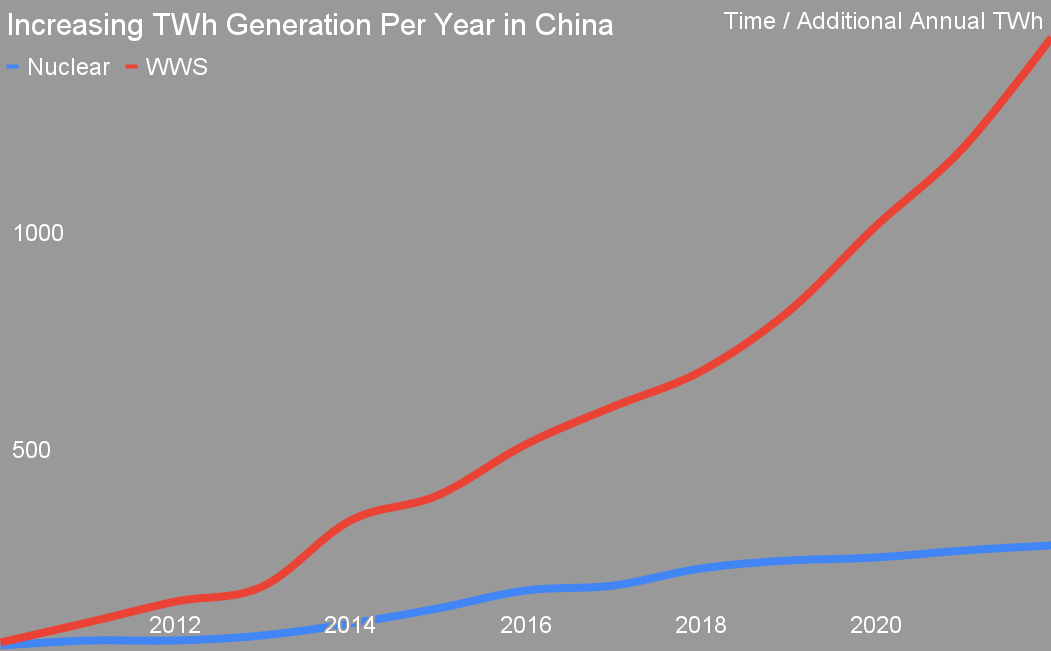
Increasing TWh Generation Per Year in China, chart by Michael Barnard, Chief Strategist, TFIE Strategy Inc.
Even China couldn’t get this right, and ironically, that’s because of market capitalism too. To explain the graph above, that’s a data set I’ve been assembling since 2014, comparing China’s wind, solar, and water deployments to its nuclear deployments. At first blush, the preconditions I listed above should have been easy for China, which is why I picked the country’s deployments. It was a great natural experiment of nuclear vs wind and solar initially, with hydro added in recently.
The graph has all four forms of generation and is in added TWh of actual new generation per year from the sources. That’s using Chinese capacity factors for all of the technologies. What it shows is that renewables are rapidly increasing their additions of real electricity per year, while nuclear is stagnant. The nuclear program peaked in 2018, and has been limping along at an average of three reactors a year since. In 2023, they’ve only connected one reactor to transmission, but haven’t started commercial operation yet. It’s possible that they will not actually get any nuclear reactors commissioned at all this year.
What went wrong? Well, they failed miserably on one of the conditions for success, picking a single, proven design and sticking to it. China built two European EPRs, the ones failing in Flamanville, Hinkley, and Olkiluoto. They also built another seven designs. They have another handful of nuclear designs of various types in labs, including a tiny molten salt reactor that thorium buffs pretend is running on their preferred radioactive metal.
And their planned reactors going forward into the future have lots of designs too. Why? Competing national strategies, is my opinion.
On the one hand, there’s a commercial nuclear strategy. On the other hand, there’s foreign sales of low-carbon generation technologies, mirroring their enormous success with solar panels and batteries, and their growing global success with wind turbines and electric vehicles.
The first requires a single design for success. The second requires whatever the customer wants to buy. China’s industrial strategy faction won the coin toss, and the power industry people lost. And so China can’t build lots of nuclear reactors quickly either.
Do Small Modular Nuclear Reactors Meet The Success Criteria?
Which brings us to small modular nuclear reactors (SMNRs), the latest great hope of the nuclear industry. This entire strategy is leaning into as many of the failure conditions of nuclear generation as it can.
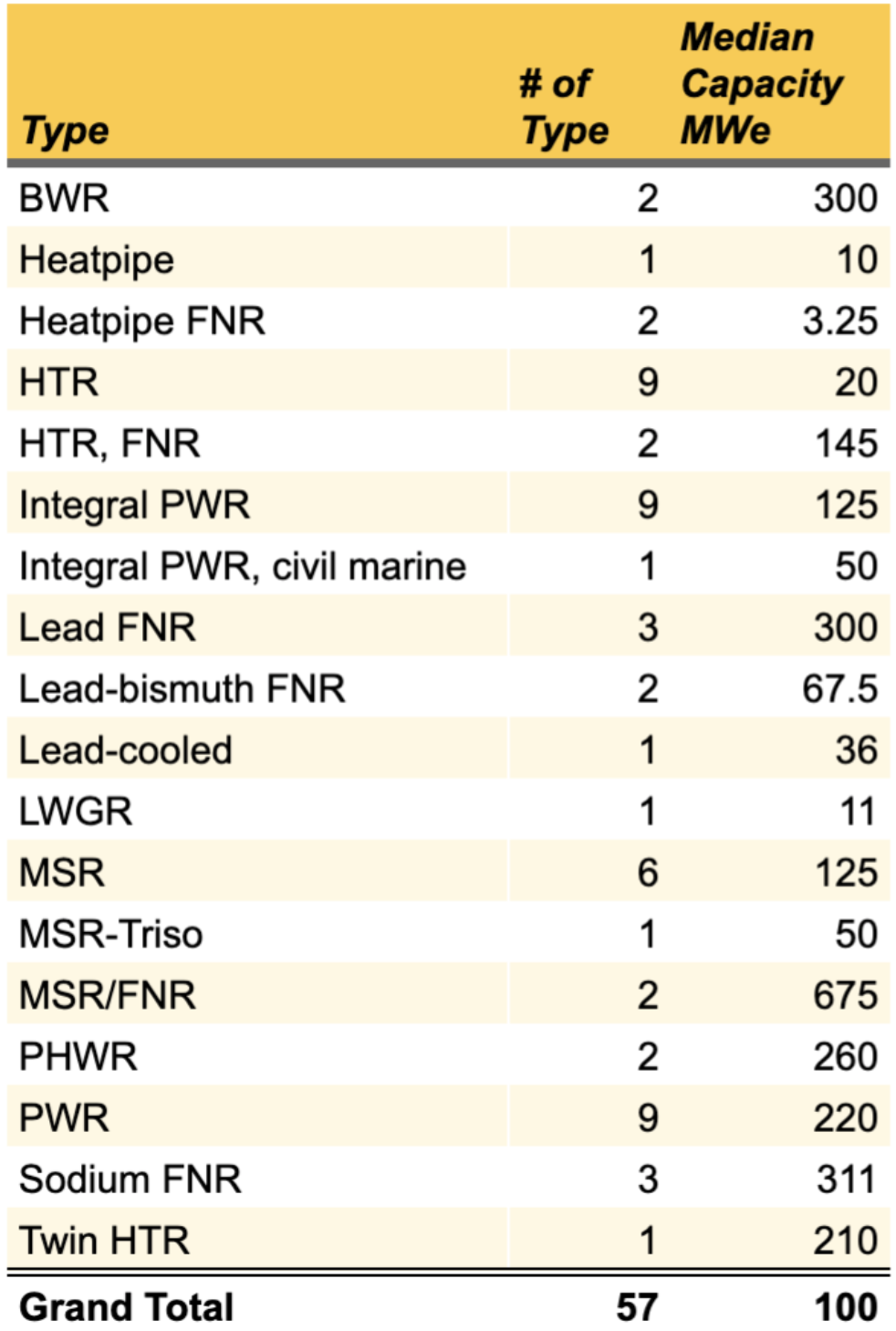
SMNR technology types, table by author with data from World Nuclear Association
It’s startups for miles. There are 18 nuclear generation technologies with 57 competing designs the last time I counted. They are all unproven technologies. They are tiny, one to two orders of magnitude below the GW-scale that thermal efficiencies requires of the technology. No government is building their low-carbon solution around them, picking winners, building dozens or hundreds, and enforcing discipline. They are depending on free market capitalism to be the wind beneath their wings.
The fiscal ideologues who seem to like nuclear power the most are ignoring the lessons of the past because their cognitive biases don’t allow them to understand that free market economics and nuclear generation go together like flame throwers and gas stations. It just doesn’t compute for them that the market sucks for some things, and that nuclear energy is one of them.
Personally, I think China will figure it out, ditch most of the designs, lean into a stable Gen 3 proven design and ramp up its nuclear program a bit. However, in the absence of a global market and the deep success of renewables, China may simply just scale back its nuclear plans. Hard to say. There are many factions within the government. It doesn’t really matter, because no matter what they do with nuclear, they’ll build enough renewables to decarbonize all of their energy anyway, and sell massive amounts of solar panels, wind turbines, batteries, and EVs globally to decarbonize a lot of it too.
Building nuclear reactors requires a Nuclear New Deal, and no government in the world seems interested in doing that. While market economics work brilliantly for lowering costs of modular, manufacturable, and simpler solutions, they don’t work for commercial nuclear generation.
Have a tip for CleanTechnica? Want to advertise? Want to suggest a guest for our CleanTech Talk podcast? Contact us here.
EV Obsession Daily!
I don’t like paywalls. You don’t like paywalls. Who likes paywalls? Here at CleanTechnica, we implemented a limited paywall for a while, but it always felt wrong — and it was always tough to decide what we should put behind there. In theory, your most exclusive and best content goes behind a paywall. But then fewer people read it!! So, we’ve decided to completely nix paywalls here at CleanTechnica. But…
Thank you!
Community Solar Benefits & Growth
CleanTechnica uses affiliate links. See our policy here.

